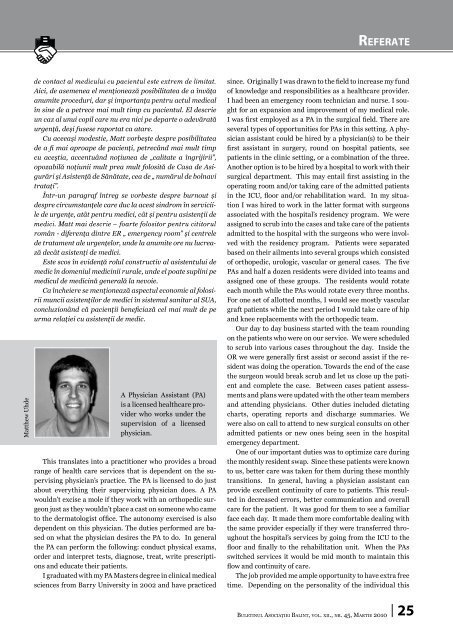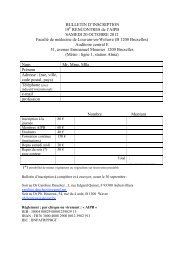Marie 2010
martie 2010 - Psychodrame Balint
martie 2010 - Psychodrame Balint
You also want an ePaper? Increase the reach of your titles
YUMPU automatically turns print PDFs into web optimized ePapers that Google loves.
ReferateMatthew Uhdede contact al medicului cu pacientul este extrem de limitat.Aici, de asemenea el menţionează posibilitatea de a învăţaanumite proceduri, dar şi importanţa pentru actul medicalîn sine de a petrece mai mult timp cu pacientul. El descrieun caz al unui copil care nu era nici pe departe o adevăratăurgenţă, deşi fusese raportat ca atare.Cu aceeaşi modestie, Matt vorbeşte despre posibilitateade a fi mai aproape de pacienţi, petrecând mai mult timpcu aceştia, accentuând noţiunea de „calitate a îngrijirii”,opozabilă noţiunii mult prea mult folosită de Casa de Asigurărişi Asistenţă de Sănătate, cea de „ numărul de bolnavitrataţi”.Într-un paragraf întreg se vorbeste despre burnout şidespre circumstanţele care duc la acest sindrom în serviciilede urgenţe, atât pentru medici, cât şi pentru asistenţii demedici. Matt mai descrie – foarte folositor pentru cititorulromân - diferenţa dintre ER „ emergency room” şi centrelede tratament ale urgenţelor, unde la anumite ore nu lucreazădecât asistenţi de medici.Este scos în evidenţă rolul constructiv al asistentului demedic în domeniul medicinii rurale, unde el poate suplini pemedicul de medicină generală la nevoie.Ca încheiere se menţionează aspectul economic al folosiriimuncii asistenţilor de medici în sistemul sanitar al SUA,concluzionând că pacienţii beneficiază cel mai mult de peurma relaţiei cu asistenţii de medic.A Physician Assistant (PA)is a licensed healthcare providerwho works under thesupervision of a licensedphysician.This translates into a practitioner who provides a broadrange of health care services that is dependent on the supervisingphysician’s practice. The PA is licensed to do justabout everything their supervising physician does. A PAwouldn’t excise a mole if they work with an orthopedic surgeonjust as they wouldn’t place a cast on someone who cameto the dermatologist office. The autonomy exercised is alsodependent on this physician. The duties performed are basedon what the physician desires the PA to do. In generalthe PA can perform the following: conduct physical exams,order and interpret tests, diagnose, treat, write prescriptionsand educate their patients.I graduated with my PA Masters degree in clinical medicalsciences from Barry University in 2002 and have practicedsince. Originally I was drawn to the field to increase my fundof knowledge and responsibilities as a healthcare provider.I had been an emergency room technician and nurse. I soughtfor an expansion and improvement of my medical role.I was first employed as a PA in the surgical field. There areseveral types of opportunities for PAs in this setting. A physicianassistant could be hired by a physician(s) to be theirfirst assistant in surgery, round on hospital patients, seepatients in the clinic setting, or a combination of the three.Another option is to be hired by a hospital to work with theirsurgical department. This may entail first assisting in theoperating room and/or taking care of the admitted patientsin the ICU, floor and/or rehabilitation ward. In my situationI was hired to work in the latter format with surgeonsassociated with the hospital’s residency program. We wereassigned to scrub into the cases and take care of the patientsadmitted to the hospital with the surgeons who were involvedwith the residency program. Patients were separatedbased on their ailments into several groups which consistedof orthopedic, urologic, vascular or general cases. The fivePAs and half a dozen residents were divided into teams andassigned one of these groups. The residents would rotateeach month while the PAs would rotate every three months.For one set of allotted months, I would see mostly vasculargraft patients while the next period I would take care of hipand knee replacements with the orthopedic team.Our day to day business started with the team roundingon the patients who were on our service. We were scheduledto scrub into various cases throughout the day. Inside theOR we were generally first assist or second assist if the residentwas doing the operation. Towards the end of the casethe surgeon would break scrub and let us close up the patientand complete the case. Between cases patient assessmentsand plans were updated with the other team membersand attending physicians. Other duties included dictatingcharts, operating reports and discharge summaries. Wewere also on call to attend to new surgical consults on otheradmitted patients or new ones being seen in the hospitalemergency department.One of our important duties was to optimize care duringthe monthly resident swap. Since these patients were knownto us, better care was taken for them during these monthlytransitions. In general, having a physician assistant canprovide excellent continuity of care to patients. This resultedin decreased errors, better communication and overallcare for the patient. It was good for them to see a familiarface each day. It made them more comfortable dealing withthe same provider especially if they were transferred throughoutthe hospital’s services by going from the ICU to thefloor and finally to the rehabilitation unit. When the PAsswitched services it would be mid month to maintain thisflow and continuity of care.The job provided me ample opportunity to have extra freetime. Depending on the personality of the individual thisBuletinul Asociaţiei Balint, vol. xii., nr. 45, Martie <strong>2010</strong>25



